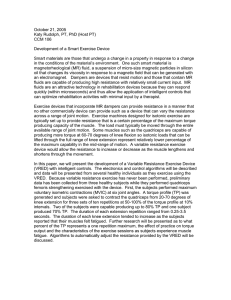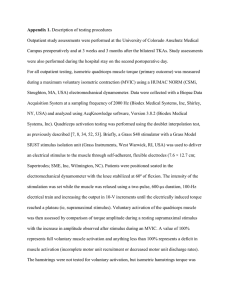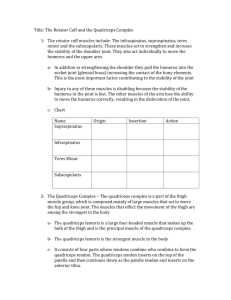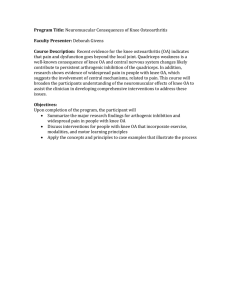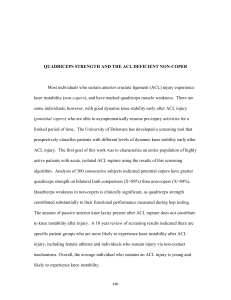Quadriceps Function After ACL Reconstruction: Muscle Size Study
advertisement
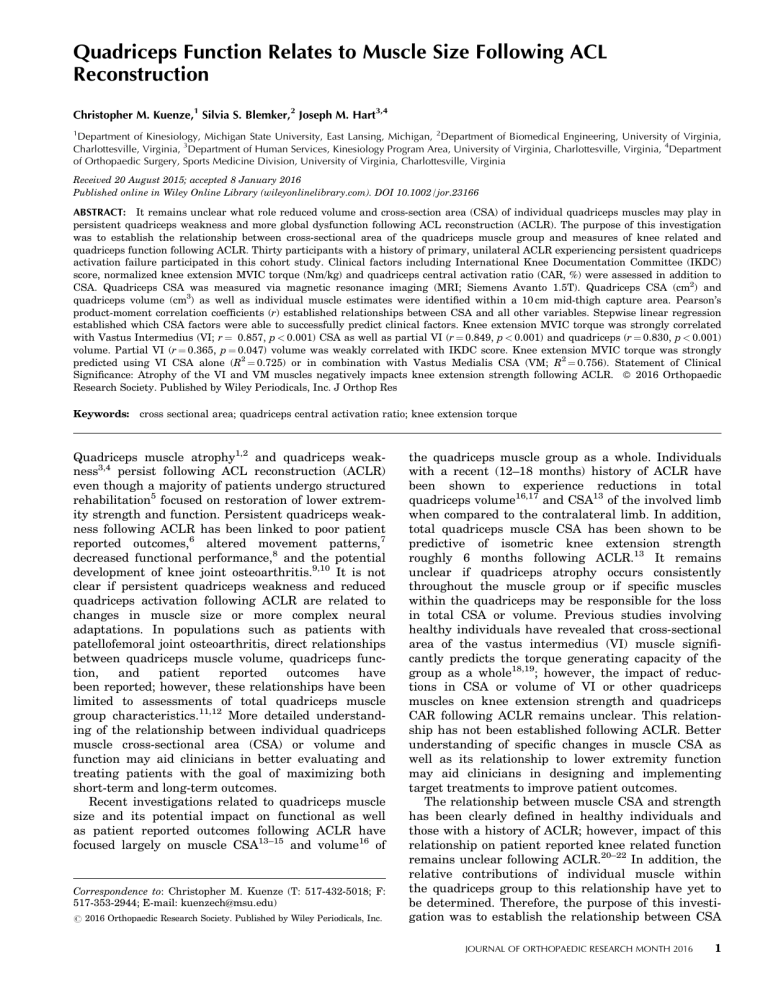
Quadriceps Function Relates to Muscle Size Following ACL Reconstruction Christopher M. Kuenze,1 Silvia S. Blemker,2 Joseph M. Hart3,4 1 Department of Kinesiology, Michigan State University, East Lansing, Michigan, 2Department of Biomedical Engineering, University of Virginia, Charlottesville, Virginia, 3Department of Human Services, Kinesiology Program Area, University of Virginia, Charlottesville, Virginia, 4Department of Orthopaedic Surgery, Sports Medicine Division, University of Virginia, Charlottesville, Virginia Received 20 August 2015; accepted 8 January 2016 Published online in Wiley Online Library (wileyonlinelibrary.com). DOI 10.1002/jor.23166 ABSTRACT: It remains unclear what role reduced volume and cross-section area (CSA) of individual quadriceps muscles may play in persistent quadriceps weakness and more global dysfunction following ACL reconstruction (ACLR). The purpose of this investigation was to establish the relationship between cross-sectional area of the quadriceps muscle group and measures of knee related and quadriceps function following ACLR. Thirty participants with a history of primary, unilateral ACLR experiencing persistent quadriceps activation failure participated in this cohort study. Clinical factors including International Knee Documentation Committee (IKDC) score, normalized knee extension MVIC torque (Nm/kg) and quadriceps central activation ratio (CAR, %) were assessed in addition to CSA. Quadriceps CSA was measured via magnetic resonance imaging (MRI; Siemens Avanto 1.5T). Quadriceps CSA (cm2) and quadriceps volume (cm3) as well as individual muscle estimates were identified within a 10 cm mid-thigh capture area. Pearson’s product-moment correlation coefficients (r) established relationships between CSA and all other variables. Stepwise linear regression established which CSA factors were able to successfully predict clinical factors. Knee extension MVIC torque was strongly correlated with Vastus Intermedius (VI; r ¼ 0.857, p < 0.001) CSA as well as partial VI (r ¼ 0.849, p < 0.001) and quadriceps (r ¼ 0.830, p < 0.001) volume. Partial VI (r ¼ 0.365, p ¼ 0.047) volume was weakly correlated with IKDC score. Knee extension MVIC torque was strongly predicted using VI CSA alone (R2 ¼ 0.725) or in combination with Vastus Medialis CSA (VM; R2 ¼ 0.756). Statement of Clinical Significance: Atrophy of the VI and VM muscles negatively impacts knee extension strength following ACLR. ß 2016 Orthopaedic Research Society. Published by Wiley Periodicals, Inc. J Orthop Res Keywords: cross sectional area; quadriceps central activation ratio; knee extension torque Quadriceps muscle atrophy1,2 and quadriceps weakness3,4 persist following ACL reconstruction (ACLR) even though a majority of patients undergo structured rehabilitation5 focused on restoration of lower extremity strength and function. Persistent quadriceps weakness following ACLR has been linked to poor patient reported outcomes,6 altered movement patterns,7 decreased functional performance,8 and the potential development of knee joint osteoarthritis.9,10 It is not clear if persistent quadriceps weakness and reduced quadriceps activation following ACLR are related to changes in muscle size or more complex neural adaptations. In populations such as patients with patellofemoral joint osteoarthritis, direct relationships between quadriceps muscle volume, quadriceps function, and patient reported outcomes have been reported; however, these relationships have been limited to assessments of total quadriceps muscle group characteristics.11,12 More detailed understanding of the relationship between individual quadriceps muscle cross-sectional area (CSA) or volume and function may aid clinicians in better evaluating and treating patients with the goal of maximizing both short-term and long-term outcomes. Recent investigations related to quadriceps muscle size and its potential impact on functional as well as patient reported outcomes following ACLR have focused largely on muscle CSA13–15 and volume16 of Correspondence to: Christopher M. Kuenze (T: 517-432-5018; F: 517-353-2944; E-mail: kuenzech@msu.edu) # 2016 Orthopaedic Research Society. Published by Wiley Periodicals, Inc. the quadriceps muscle group as a whole. Individuals with a recent (12–18 months) history of ACLR have been shown to experience reductions in total quadriceps volume16,17 and CSA13 of the involved limb when compared to the contralateral limb. In addition, total quadriceps muscle CSA has been shown to be predictive of isometric knee extension strength roughly 6 months following ACLR.13 It remains unclear if quadriceps atrophy occurs consistently throughout the muscle group or if specific muscles within the quadriceps may be responsible for the loss in total CSA or volume. Previous studies involving healthy individuals have revealed that cross-sectional area of the vastus intermedius (VI) muscle significantly predicts the torque generating capacity of the group as a whole18,19; however, the impact of reductions in CSA or volume of VI or other quadriceps muscles on knee extension strength and quadriceps CAR following ACLR remains unclear. This relationship has not been established following ACLR. Better understanding of specific changes in muscle CSA as well as its relationship to lower extremity function may aid clinicians in designing and implementing target treatments to improve patient outcomes. The relationship between muscle CSA and strength has been clearly defined in healthy individuals and those with a history of ACLR; however, impact of this relationship on patient reported knee related function remains unclear following ACLR.20–22 In addition, the relative contributions of individual muscle within the quadriceps group to this relationship have yet to be determined. Therefore, the purpose of this investigation was to establish the relationship between CSA JOURNAL OF ORTHOPAEDIC RESEARCH MONTH 2016 1 2 KUENZE ET AL. and partial muscle volume of individual muscles within the quadriceps at a point 10 cm superior to the base of the patella and measures of knee related function and quadriceps strength in individuals with a history of ACLR. This approach to MRI based measurement of muscle size was taken in order to ensure that all four muscles within the quadriceps group would be included in all images. We hypothesized that individuals with larger quadriceps muscle CSA would display better self-reported knee related function, greater knee extension strength, and greater quadriceps activation than those with smaller CSA. METHODS A total of 33 potential participants with a history of primary, unilateral ACLR were recruited and screened for enrollment in this retrospective cohort study (Level III evidence). All participants had undergone ACLR at least 6 months prior to enrollment and had evidence of persistent reduction in quadriceps activation which was established as a quadriceps central activation ratio (CAR) less than 90.0%). This cutoff was selected based on the recommendation for healthy quadriceps activation (CAR 95.0%)23 and the error associated with the manually triggered stimulation technique utilized in this investigation (Error ¼ 5.1%).24 All participants had been released by their physician to resume full physical activity without restriction. Participants were excluded from this study if they reported multiple ligament injury, significant surgical complications resulting in prolonged post-operative treatment or a second surgical procedure, or current pregnancy. Three participants were excluded at the time of screening including two with lack of measurable quadriceps activation failure and one with a reported multiple ligament injury. Therefore, 30 participants were successfully enrolled in this study (Table 1). This study was approved by the IRB at the University of Virginia and all participants provided informed consent prior to enrollment. Clinical Outcome Measures All clinical outcome measures were assessed during the first of two testing sessions which occurred within 48 h of each other. Participants were assessed for inclusion and exclusion criteria, patient reported knee related function was assessed using the International Knee Documentation Committee (IKDC) 2,000 form and knee extension strength and quadriceps activation were assessed. Knee Extension MVIC Torque Knee extension MVIC torque was assessed in the involved limb using Biodex multimodal dynamometer (System 3, Biodex Medical Systems, Inc, Shirley, NY). Data were exported using the remote access port and digitized at 125 Hz (MP150, Biopac Systems, Inc, Santa Barbara, CA). Participants were secured to the chair and asked to maintain good seated posture with their hip and knee flexed to 80˚ and 90˚, respectively. Participants then completed practice knee extension trials of 50%, 75%, and two practice trials at 100% of perceived effort. Participants were given 1 min of rest between each trials to reduce potential fatigue. The investigator provided constant verbal encouragement such as “keep going” and “push harder” until the participant achieve a plateau representing MVIC JOURNAL OF ORTHOPAEDIC RESEARCH MONTH 2016 Table 1. Demographic and Quadriceps Function Data Mean SD Sex (M/F) Age (years) Height (cm) Mass (kg) Time since reconstruction (mo) International knee documentation committee score (%) Knee extension MVIC torque (Nm) Normalized knee extension MVIC torque (Nm/kg) Quadriceps central activation ratio (%) Partial rectus femoris volume (cm3) Partial vastus lateralis volume (cm3) Partial vastus medialis volume (cm3) Partial vastus intermedius volume (cm3) Partial total quadriceps volume (cm3) Rectus femoris CSA (cm2) Vastus lateralis CSA (cm2) Vastus medialis CSA (cm2) Vastus intermedius CSA (cm2) Total quadriceps CSA (cm2) 10 M/20 F 27.3 11.4 167.4 8.8 73.3 12.2 34 42 77.0 12.02 92.67 32.30 1.54 0.41 75.79 48.00 206.43 229.30 215.03 698.77 2.51 13.51 16.94 16.69 51.49 9.71 14.00 45.52 62.68 52.36 149.08 1.18 3.08 4.59 3.85 10.24 CSA, cross sectional area; MVIC, maximal voluntary isometric contraction. for a minimum of 2 s.25 Subjective evaluation of each trial was immediately completed by the investigator and trials with excessive force fluctuations were re-done after a sufficient rest period. All participants completed two trials that were deemed appropriate for analysis. Non-normalized knee extension MVIC torque was included in all analyses; however, normalized knee extension MVIC torque (Nm/kg) was presented in Table 1 as demographic information. Quadriceps Central Activation Ratio Quadriceps central activation ratio (CAR) was measured in the involved limb at the same time as knee extension MVIC torque using the burst superimposition technique.26,27 During each knee extension trial, a torque plateau representing the MVIC was manually identified and a 100 ms train of 10 square-wave pulses at an intensity of 125 V was delivered to the quadriceps via two 300 500 pre-gelled stimulating electrodes using a Grass S88 dual-output square-pulse stimulator with the Grass SIU8T stimulus isolation unit (Grass-Telefactor, West Warwick, RI). Stimulating electrodes were placed over the proximal vastus lateralis and distal vastus medialis and held in place using a non-conductive elastic bandage. This stimulus produced an increase in torque (TSIB) known as a superimposed burst which was compared to torque value for the 200 ms window immediately prior to the superimposed burst (TMVIC, Fig. 1). Comparison of these values enable us to calculate the quadriceps central activation ratio (Equation 1).28 CAR ¼ TMVIC ðTMVIC þ TSIB Þ ð1Þ Equation 1. Calculation of quadriceps central activation ratio (CAR). MVIC ¼ maximal volitional isometric contraction, T ¼ torque, SIB ¼ superimposed burst. QUADRICEPS CSA AFTER ACL RECONSTRUCTION Figure 1. Representation of a characteristic knee extension maximum voluntary isometric contraction (MVIC) torque curve as well as the identification of peak knee extension MVIC torque (TMVIC) and peak quadriceps superimposed burst torque (TSIB). These variables were then used to calculate the quadriceps central activation ratio (CAR). Quadriceps MRI Participants reported for the second of two study visits. Patients were supine throughout the scan with the knee slightly flexed. Magnetic resonance imaging (MRI) scans were acquired using Siemens Avanto 1.5T MRI scanner using an extremity RF coil for signal reception. A turbo spin echo (TSE) pulse sequence with a repetition time (TR) of over 2.5 s and echo times (TE) of 11, 92, and 172 ms was used to obtain 10 slices (each 10 cm thick) of the thigh. A laser-cross hair was used to standardize the positioning of the involved limb within the MRI coil. As this investigation was a part of a larger study which included multiple MRIs across multiple days, an easily identifiable and repeatable landmark (a point 10 cm proximal to the base of the patella) was utilized as a reference position for all participants. Based on pilot data collected prior to initiation of this investigation, this reference point ensured that all four muscles within the quadriceps muscle group would be included in the 10 cm scan area. Quadriceps CSA and Partial Quadriceps Volume Using the MRI scans acquired for all 30 participants, crosssectional area and quadriceps volume measurement was completed for the 10 cm target area each muscle within the quadriceps muscle group as well as for the quadriceps muscle group as a whole. All data processing was completed by three experienced research assistants who were trained using methodology consistent with previous investigation using this software package.29 A single trained and experienced study team member, who was involved in the development of this methodology, reviewed and refined all segmentation and data output to insure data quality prior to inclusion in the data set.29 Segmentation of the 10 cm scan area was completed using a custom in-house segmentation software (MSEG) written in Matlab (The Mathworks Inc., Natick, MA). A trained segmenter manually identified the fascial boarders of the rectus femoris (RF), vastus lateralis (VL), vastus intermedius (VI), and vastus medialis (VM) muscle on each of the 10 MRI scan slices for each of the 30 participants (Fig. 2). Inter- and intra-rater reliability of this technique has been established for lower extremity muscles within a pediatric clinical population30 as well as an adult population.31 Although inter-rater and intra-rater reliability 3 Figure 2. Example of thigh MRI scan segmentation with the muscle of the quadriceps highlighted. Quadriceps crosssectional area (CSA) was measured using the segmentation contours established during this stage of data processing. VL, vastus lateralis; RF, rectus femoris; VM, vastus medialis; VI, vastus intermedius. associated with segmentation in the pediatric population was deemed to be acceptable despite some variability in muscle boarder identification due to the relatively small size of pediatric musculature, boarder identification in within the adult population has been found to be excellent (ICC ¼ 0.992–0.996).31 CSA (cm2) was measured for each muscle on each of the 10 slices and the peak value was considered CSA. Total quadriceps muscle group CSA was defined as the slice in which the sum of the four individual muscle CSAs was greatest. Using the custom MSEG software, the volume of the 10 cm target area was also measured (cm3). A representation of the capture area, segmentation, and 3D muscle reconstruction can be seen in Figure. 3. Statistical Analysis The sample size for this investigation was based on the quadriceps function related outcome measures as this was part of a larger prospective investigation.32 Means and standard deviations were calculated for all clinical and MRI outcome variables of interest. We utilized Pearson’s bivariate correlation coefficients (r) to establish the relationships between clinical factors (IKDC, knee extension MVIC strength, and quadriceps CAR), quadriceps CSA, and partial quadriceps volume. In addition, we utilized stepwise linear regression to establish the ability of quadriceps CSA and partial quadriceps volume to predict clinical factors in those with a history of ACLR. A minimum collinearity tolerance of 0.10 and a maximal variance inflation factor of 10.0 were utilized in order to ensure that variables retained in regression models were not redundant or significantly collinear. Statistical analyses were performed using SPSS for Windows (version 22.0; IBM Inc, Chicago, IL). A priori alpha level was established as p 0.05 for all correlation and regression findings. RESULTS Mean and standard deviation values of all patient reported, clinical, and MRI outcome variables can be found in Table 1. JOURNAL OF ORTHOPAEDIC RESEARCH MONTH 2016 4 KUENZE ET AL. Figure 3. Example of muscle segmentation output rendered into a 3-D representation of the quadriceps muscle group. Individual quadriceps muscle as well as quadriceps muscle group volume was measured using these renderings. VL, vastus lateralis; RF, rectus femoris; VM, vastus medialis; VI, vastus intermedius. Correlations Between Outcome Variables Knee extension MVIC torque was strongly correlated with VI (r ¼ 0.857, p < 0.001) CSA as well as partial VI (r ¼ 0.849, p < 0.001) and quadriceps (r ¼ 0.830, p < 0.001) volume. Knee extension MVIC torque was moderately correlated with VM (r ¼ 0.669, p < 0.001), VL (r ¼ 0.469, p ¼ 0.009), and quadriceps (r ¼ 0.764, p < 0.001) CSA as well as partial VM (r ¼ 0.747, p < 0.001) and VL (r ¼ 0.607, p < 0.001) volume. Partial VI (r ¼ 0.365, p ¼ 0.047) volume was weakly correlated with IKDC score. Quadriceps CAR was not significantly related to quadriceps CSA (Table 2). Predictors of Patient Reported and Quadriceps Function Stepwise linear regression revealed that knee extension MVIC torque was strongly predicted using VI CSA alone (R2 ¼ 0.725) or in combination with VM CSA (R2 ¼ 0.756; Table 3). IKDC score was weakly predicted by partial VI (R2 ¼ 0.102) volume. Quadriceps CAR was not significantly predicted by quadriceps CSA. DISCUSSION Persistent quadriceps atrophy,13,14 quadriceps muscle dysfunction,3–33 and reduced knee related function34,35 have been consistently reported following ACLR. To our knowledge, this is the first investigation that has addressed the relationship between the volume and CSA of individual quadriceps muscles with measures of quadriceps function and self-reported function in those with a history of ACLR. Based our findings, it appears that VI and VM CSA plays an important role in development of knee extension strength following ACLR. These findings support the importance of addressing quadriceps muscle atrophy, specifically of the VM and VI muscles, when attempting to improve peak knee extension MVIC torque following ACLR in order to optimize patient outcomes. Further, quadriceps CAR was not related to any of the quadriceps morphologic measures presented in this study. This finding indicates that the underlying sources of persistent decrements in knee extension MVIC torque and quadriceps CAR, both of which are commonly reported Table 2. Relationships Between Quadriceps MRI Measures and Clinical Outcome Measures Partial rectus femoris volume (cm3) Partial vastus lateralis volume (cm3) Partial vastus medialis volume (cm3) Partial vastus intermedius volume (cm3) Partial quadriceps volume (cm3) Rectus femoris CSA (cm2) Vastus lateralis CSA (cm2) Vastus Medialis CSA (cm2) Vastus Intermedius CSA (cm2) Quadriceps CSA (cm2) CSA, cross sectional area; CAR, central activation ratio. p 0.05. JOURNAL OF ORTHOPAEDIC RESEARCH MONTH 2016 Knee Extension MVIC Torque Quadriceps CAR IKDC 2000 Score 0.300 0.607 0.747 0.849 0.830 0.007 0.469 0.669 0.857 0.764 0.045 0.058 0.058 0.122 0.004 0.120 0.072 0.136 0.149 0.053 0.068 0.314 0.253 0.356 0.339 0.017 0.341 0.188 0.341 0.310 QUADRICEPS CSA AFTER ACL RECONSTRUCTION 5 Table 3. Stepwise Linear Regression Results for Prediction of Clinical Outcomes Using Quadriceps Cross-sectional Area and Partial Volume Significant Predictors IKDC 2000 score Knee extension MVIC torque Quadriceps central activation ratio Partial vastus intermedius volume Vastus intermedius CSA Vastus medialis CSA No variables entered F Statistic p Value R2 Value 4.304 77.558 45.808 0.047 <0.001 <0.001 0.102 0.725 0.756 IKDC, international knee documentation committee; MVIC, maximum voluntary isometric contraction; CSA, cross sectional area. after ACLR, may in fact be different. The persistent reductions in strength appear to be directly related to atrophy of individual quadriceps muscles where reduced quadriceps CAR is not significantly explained by this underlying process. Quadriceps muscle CSA and volume have been shown to successfully predict quadriceps strength in healthy individuals20 and those with a history of ACLR14–16; however, the relative contribution or relationship between each individual muscle within the quadriceps group has not been previously investigated following ACLR. The relationship between individual muscle activity and both knee extension torque and quadriceps muscle force has been addressed through muscle modeling and in vivo healthy subjects research.18,19–32 It has been consistently shown that the size and activation of the vasti muscles (VM, VL, VI) successfully predict quadriceps function.18,19–36 Based on our findings, this relationship appears to remain following ACLR (Table 2). Interestingly, we found that CSA of the VI was not only strongly related to knee extension MVIC torque but the VI CSA was also able to predict 75.5% of the variance in knee extension MVIC torque among those with ACLR. This was consistent with prior research regarding to the ability of VI CSA to predict knee extension MVIC torque (R2 ¼ 66.0%) in healthy individuals which indicates a significant relationship between torque generating capacity and the size of the VI muscle.18 Based on these findings, atrophy of the VI may be a major indicator of more global quadriceps dysfunction following ACLR. Quadriceps strength and strength asymmetry have been shown to impact lower extremity function7–37 following ACLR. While recent research has highlighted the effectiveness of several novel intervention techniques in this population such as the use of disinhibitory modalities,38 it remains unclear if these interventions are effective in increasing overall quadriceps CSA, and more specifically generating a measurable improvement in VI CSA, following ACLR. The neurological facilitation of the quadriceps undoubtedly plays an important role in restoration of normal quadriceps function38; however, based on the results of our investigation in conjunction with previous findings in healthy populations,18restoration of VI and VM CSA, and volume may be the key to restoring isometric knee extension strength to pre-injury levels. Therefore, based on the relationship between knee extension torque and quadriceps CSA, increased focus on development of strategies to improve both CSA and knee extension torque may aid in targeted restoration of more general lower extremity function following ACLR. Patient reported knee related function as measured using the IKDC was weakly predicted by the partial volume of the VI (R2 ¼ 0.102). Previous investigations have indicated a moderate to strong relationship between total quadriceps CSA and both knee related function and physical activity level following ACLR; however, this was not the case in our study.15 Individuals with greater total CSA have reported better knee related function as well as higher physical activity levels.15 While previous hypotheses have indicated that the relationship between greater muscle size and better patient reported function may be related to improved quadriceps force generating capacity or knee related function, this was not the case in our data. This disagrees with previous investigations35 reporting a significant predictive relationship between quadriceps strength and patient reported function over time; however, due to the cross-sectional nature of our investigation as well as the relatively heterogeneous demographic and surgical characteristics within our sample, it may be possible that VI size is less sensitive to factors which may confound strength assessment such as patient effort. Quadriceps activation failure has been highlighted as an important sign of quadriceps neuromuscular3–35 and corticospinal3–35 dysfunction following ACLR. The lack of relationship between quadriceps CAR and quadriceps size in this investigation is consistent with the limited available previous evidence regarding individuals with a history of ACLR.13 Previous investigations have indicated that quadriceps CAR is more likely related to alterations in neurological function such as arthrogenic or autogenic inhibition.35–39 Our findings support the hypothesis that persistent deficits in quadriceps CAR following ACLR are not related to quadriceps CSA or volume. This is in contrast to knee extension torque which was been, including the results of this investigation, directly related to post-surgical changes in quadriceps size. While quadriceps CSA may determine the relative magnitude of knee extension torque, the ability to fully activate the alpha motor neurons associated with the quadriceps JOURNAL OF ORTHOPAEDIC RESEARCH MONTH 2016 6 KUENZE ET AL. muscle is considered to be the primary determinate of quadriceps activation.27 This is an important distinction that may lend additional support to evaluation of both knee extension strength and quadriceps activation following ACLR. Based on the relationship to total quadriceps CSA and volume as well as the significant predictive ability of VM and VI CSA, the ability to evaluate knee extension strength and quadriceps CAR independently may provide clinicians the ability to better understand whether the source of persistent quadriceps dysfunction is limited to atrophy of the vastus muscles or if a more complex underlying neurological mechanism may be implicated. As this was a part of a larger prospective investigation that focused on individuals with persistent quadriceps dysfunction following ACLR, the graft source and time since surgery was not limited or controlled for among participants. The use of broad inclusion criteria was purposeful but may have had a significant impact on our findings. Specifically, the broad spectrum of time since surgery (34 42 months) may have led to the inclusion of participants whom were experiencing muscle weakness or central activation deficits due to different underlying mechanisms or sources. Based on the capacity of our custom written software, the authors were limited to a calculation of anatomical CSA which may have reduced the strength of the relationships between quadriceps CSA and isometric knee extension torque. Anatomical CSA does not take into account the angle of pennation within a muscle which is a key determinant of peak force generating capacity. In addition, the authors did not calculate interrater reliability statistics despite having multiple research assistants responsible for muscle segmentation which may have impacted the between subject error associated with our measurements. The inclusion of oversight by a trained segmenter is consistent with previous investigations utilizing this approach to segmentation but future investigation in this area should be limited to a single assessor or provide clearer estimation of between assessor error.29 Additionally, the MRI scans utilized in this investigation were limited to a 10 cm area of the thigh which may have resulted in between participant inconsistencies in capture area. This location was selected to estimate the area of largest CSA in the quadriceps and all relationships were established in a within subjects manner which aided in reducing the potential impact of this limitation. Lastly, the torque data collected in this investigation was limited to isometric contractions which may not be as closely related to clinical based measures of lower extremity as isokinetic torque has been shown to be.40 Future investigations should expand upon the findings of this study by describing the relationship between quadriceps CSA and isokinetic quadriceps torque in order to improve the clinical applicability of our findings. JOURNAL OF ORTHOPAEDIC RESEARCH MONTH 2016 CONCLUSION In patients with a history of ACLR, knee extension MVIC torque but not quadriceps CAR was related to CSA and partial volume of the VI, VM, and quadriceps muscle group as a whole. These findings suggest that individual heads of the quadriceps may play different roles in development of knee extension strength and with patient reported outcomes in patients with chronic ACLR. AUTHORS’ CONTRIBUTION Christopher Kuenze and Joseph Hart were responsible for study design and data collection while all authors were involved in the analysis and interpretation of the data presented. All authors were involved in drafting and reviewing the manuscript. All authors have read and approved the manuscript as submitted. REFERENCES 1. Marcon M, Ciritsis B, Laux C, et al. 2015. Quantitative and qualitative MR-imaging assessment of vastus medialis muscle volume loss in asymptomatic patients after anterior cruciate ligament reconstruction. J Magn Reson Imaging 42:515–525. 2. Marcon M, Ciritsis B, Laux C, et al. 2015. Cross-sectional area measurements versus volumetric assessment of the quadriceps femoris muscle in patients with anterior cruciate ligament reconstructions. Eur Radiol 25:290–298. 3. Kuenze CM, Hertel J, Weltman A, et al. 2015. Persistent neuromuscular and corticomotor quadriceps asymmetry after anterior cruciate ligament reconstruction. J Athl Train 50:303–312. 4. Thomas AC, Villwock M, Wojtys EM, et al. 2013. Lower extremity muscle strength after anterior cruciate ligament injury and reconstruction. J Athl Train 48:610–620. 5. Grant JA. 2013. Updating recommendations for rehabilitation after ACL reconstruction: a review. Clin J Sport Med 23:501–502. 6. Kuenze C, Hertel J, Saliba S, et al. 2015. Clinical thresholds for quadriceps assessment after anterior cruciate ligament reconstruction. J Sport Rehabil 24:36–46. 7. Lewek M, Rudolph K, Axe M, et al. 2002. The effect of insufficient quadriceps strength on gait after anterior cruciate ligament reconstruction. Clin Biomech (Bristol, Avon) 17:56–63. 8. Dunn WR, Spindler KP. 2010. Predictors of activity level 2 years after anterior cruciate ligament reconstruction (ACLR): a Multicenter Orthopaedic Outcomes Network (MOON) ACLR cohort study. Am J Sports Med 38:2040–2050. 9. Tourville TW, Jarrell KM, Naud S, et al. 2014. Relationship between isokinetic strength and tibiofemoral joint space width changes after anterior cruciate ligament reconstruction. Am J Sports Med 42:302–311. 10. Oiestad BE, Holm I, Gunderson R, et al. 2010. Quadriceps muscle weakness after anterior cruciate ligament reconstruction: a risk factor for knee osteoarthritis? Arthritis Care Res (Hoboken) 62:1706–1714. 11. Hart HF, Ackland DC, Pandy MG, et al. 2012. Quadriceps volumes are reduced in people with patellofemoral joint osteoarthritis. Osteoarthritis Cartilage 20:863–868. 12. Toumi H, Best TM, Mazor M, et al. 2014. Association between individual quadriceps muscle volume/enthesis and patello femoral joint cartilage morphology. Arthritis Res Ther 16:R1. QUADRICEPS CSA AFTER ACL RECONSTRUCTION 13. Thomas AC, Wojtys EM, Brandon C, et al. 2015. Muscle atrophy contributes to quadriceps weakness after ACL reconstruction. J Sci Med Sport 19:7–11. 14. Arangio GA, Chen C, Kalady M, et al. 1997. Thigh muscle size and strength after anterior cruciate ligament reconstruction and rehabilitation. J Orthop Sports Phys Ther 26:238–243. 15. Lindstrom M, Strandberg S, Wredmark T, et al. 2013. Functional and muscle morphometric effects of ACL reconstruction. A prospective CT study with 1 year follow-up. Scand J Med Sci Sports 23:431–442. 16. Konishi Y, Ikeda K, Nishino A, et al. 2007. Relationship between quadriceps femoris muscle volume and muscle torque after anterior cruciate ligament repair. Scand J Med Sci Sports 17:656–661. 17. Konishi Y, Oda T, Tsukazaki S, et al. 2012. Relationship between quadriceps femoris muscle volume and muscle torque at least 18 months after anterior cruciate ligament reconstruction. Scand J Med Sci Sports 22:791–796. 18. Ando R, Saito A, Umemura Y, et al. 2015. Local architecture of the vastus intermedius is a better predictor of knee extension force than that of the other quadriceps femoris muscle heads. Clin Physiol Funct Imaging 35:376–382. 19. Akima H, Saito A. 2013. Inverse activation between the deeper vastus intermedius and superficial muscles in the quadriceps during dynamic knee extensions. Muscle Nerve 47:682–690. 20. Fukunaga T, Miyatani M, Tachi M, et al. 2001. Muscle volume is a major determinant of joint torque in humans. Acta Physiol Scand 172:249–255. 21. Holzbaur KR, Delp SL, Gold GE, et al. 2007. Momentgenerating capacity of upper limb muscles in healthy adults. J Biomech 40:2442–2449. 22. Trappe SW, Trappe TA, Lee GA, et al. 2001. Calf muscle strength in humans. Int J Sports Med 22:186–191. 23. Stackhouse SK, Stevens JE, Lee SC, et al. 2001. Maximum voluntary activation in nonfatigued and fatigued muscle of young and elderly individuals. Phys Ther 81:1102–1109. 24. Krishnan C, Allen EJ, Williams GN. 2009. Torque-based triggering improves stimulus timing precision in activation tests. Muscle Nerve 40:130–133. 25. Roberts D, Kuenze C, Saliba S, et al. 2012. Accessory muscle activation during the superimposed burst technique. J Electromyogr Kinesiol 22:540–545. 26. Hart JM, Fritz JM, Kerrigan DC, et al. 2006. Quadriceps inhibition after repetitive lumbar extension exercise in persons with a history of low back pain. J Athl Train 41:264–269. 27. Snyder-Mackler L, De Luca PF, Williams PR, et al. 1994. Reflex inhibition of the quadriceps femoris muscle after injury or reconstruction of the anterior cruciate ligament. J Bone Joint Surg Am 76:555–560. 7 28. Kent-Braun JA, Le Blanc R. 1996. Quantitation of central activation failure during maximal voluntary contractions in humans. Muscle Nerve 19:861–869. 29. Handsfield GG, Meyer CH, Hart JM, et al. 2014. Relationships of 35 lower limb muscles to height and body mass quantified using MRI. J Biomech 47:631–638. 30. Handsfield GG, Meyer CH, Abel MF, et al. 2015. Heterogeneity of muscle sizes in the lower limbs of children with cerebral palsy. Muscle Nerve. doi: 10.1002/mus.24972 [Epub ahead of print]. 31. Barnouin Y, Butler-Browne G, Voit T, et al. 2014. Manual segmentation of individual muscles of the quadriceps femoris using MRI: a reappraisal. J Magn Reson Imaging 40:239–247. 32. Hart JM, Kuenze CM, Diduch DR, et al. 2014. Quadriceps muscle function after rehabilitation with cryotherapy in patients with anterior cruciate ligament reconstruction. J Athl Train 49:733–739. 33. Hart JM, Pietrosimone B, Hertel J, et al. 2010. Quadriceps activation following knee injuries: a systematic review. J Athl Train 45:87–97. 34. Logerstedt D, Lynch A, Axe MJ, et al. 2013. Pre-operative quadriceps strength predicts IKDC2000 scores 6 months after anterior cruciate ligament reconstruction. Knee 20:208–212. 35. Pietrosimone BG, Lepley AS, Ericksen HM, et al. 2013. Quadriceps strength and corticospinal excitability as predictors of disability after anterior cruciate ligament reconstruction. J Sport Rehabil 22:1–6. 36. Watanabe K, Akima H. 2011. Effect of knee joint angle on neuromuscular activation of the vastus intermedius muscle during isometric contraction. Scand J Med Sci Sports 21: e412–e420. 37. Petschnig R, Baron R, Albrecht M. 1998. The relationship between isokinetic quadriceps strength test and hop tests for distance and one-legged vertical jump test following anterior cruciate ligament reconstruction. J Orthop Sports Phys Ther 28:23–31. 38. Harkey MS, Gribble PA, Pietrosimone BG. 2014. Disinhibitory interventions and voluntary quadriceps activation: a systematic review. J Athl Train 49:411–421. 39. Hoffman M, Koceja DM. 2000. Hoffmann reflex profiles and strength ratios in postoperative anterior cruciate ligament reconstruction patients. Int J Neurosci 104:17–27. 40. Hsieh CJ, Indelicato PA, Moser MW. 2014. Speed, not magnitude, of knee extensor torque production is associated with self-reported knee function early after anterior cruciate ligament reconstruction. Knee Surg Sports Traumatol Arthrosc 23:3214–3220. JOURNAL OF ORTHOPAEDIC RESEARCH MONTH 2016
